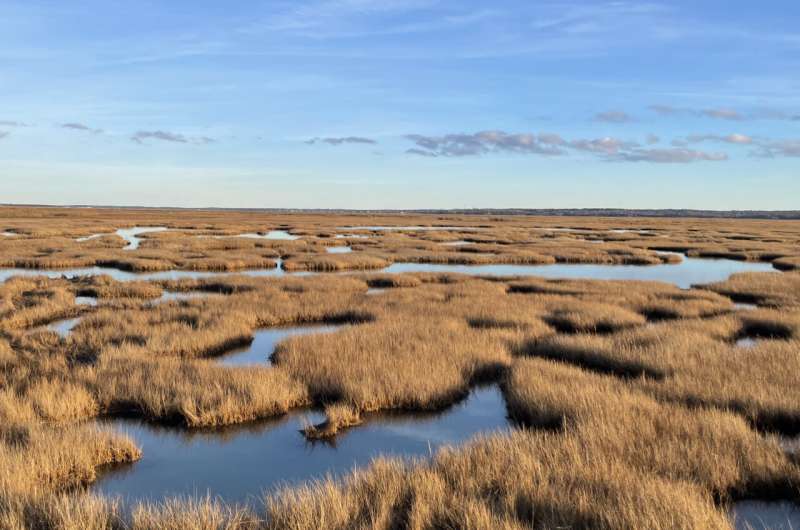This article has been reviewed according to Science X's editorial process and policies. Editors have highlighted the following attributes while ensuring the content's credibility:
fact-checked
peer-reviewed publication
trusted source
proofread
When sea-level rise threatens coastal wetlands, don't look to rivers for help, scientists say

Amid climate change, large dam removal projects have gained attention as a solution to the loss of coastal wetlands that reduce flooding, filter water, and provide wildlife habitat. But in a paper appearing in Science, researchers conclude that this strategy won't work in most U.S. rivers.
The reason, they said, is not enough sediment. Of the nearly 5,000 rivers analyzed, almost three out of every four could not deliver enough sediment to match sea-level rise in their connected coastal areas. Nearly half fell short of the amount of sediment needed by at least 10-fold.
This is the first national study to examine how much watershed sediment could be deposited by rivers into coastal areas. Until now, research has focused on a few very large rivers like the Mississippi, and steep rivers like the Elwha in Washington, that are not representative of most others in the contiguous United States.
According to the researchers, most U.S. watersheds are small and are not the leading source of sediment buildup in wetlands. It's on these small rivers that most dams exist.
Research Scientist Scott Ensign, Ph.D., of Stroud Water Research Center, a nonprofit that studies freshwater streams and rivers around the world, led the study. He said, "The Elwha is the poster child for a dam removal project restoring coastal sediment, and for good reason: it liberated an enormous amount of sediment and sand."
"However, rivers along the East and Gulf coasts are less steep than on the West Coast, and they have less sediment that could potentially reach wetlands—wetlands that are larger, requiring more sediment to keep them above rising seas. Basically, the numbers don't add up."
Christopher Craft, Ph.D., a professor at the University of Indiana who focuses on wetland restoration and climate change, said, "The expansive and comprehensive spatial analysis conducted by the authors strongly suggests that sediment supply of most coastal watersheds is inadequate to sustain tidal wetlands as sea level rises. In other words, sediment will not save them."
Ensign and his co-authors, Joanne Halls from the University of North Carolina and Erin Peck from the University of Massachusetts, used publicly available data from the U.S. Geological Survey and National Oceanic and Atmospheric Administration to model the supply of watershed sediment to coastal wetlands using ArcGIS Pro technology from Esri. They then compared their predictions to tidal wetlands around the U.S. with previously reported rates of change.
"By and large, the sediment that saves most wetlands from drowning doesn't come from the river upstream. In many places on the East Coast, removing dams won't help. We have to look elsewhere," Ensign explained.
James Pizzuto, Ph.D., a professor of geological sciences specializing in river science at the University of Delaware, said that the researchers cleverly addressed a complex problem.
"These results, and the local variations documented by mapping the entire coastal U.S., provide essential guidance to managers and scientists, documenting where future efforts should focus on other processes beyond watershed sediment," he said.
Such efforts might include finding ways to keep more mineral sediments, plant material, and organic carbon in wetland soils, explained Donald F. Boesch, professor emeritus of the University of Maryland Center for Environmental Science. He said, "This is true both where they are sediment-starved and where sediments are being diverted to build and maintain wetlands experiencing high rates of relative sea-level rise, such as in the Mississippi Delta."
Future studies are needed to measure how much sediment is trapped behind specific dams and to accurately predict its effect on tidal wetlands downstream.
Ensign said, "Across the board, the most important action for saving tidal wetlands is to allow them to migrate upslope. In some areas, this will require restoring natural hydrology and preserving low-lying land. Direct application of sediment and other engineering approaches can also be useful at very local scales."
More information: Scott H. Ensign et al, Watershed sediment cannot offset sea level rise in most U.S. tidal wetlands, Science (2023). DOI: 10.1126/science.adj0513. www.science.org/doi/10.1126/science.adj0513
Laurel G. Larsen et al, Tidal marshes threatened by lack of sediment, Science (2023). DOI: 10.1126/science.adl4251. www.science.org/doi/10.1126/science.adl4251
Journal information: Science
Provided by Stroud Water Research Center




















